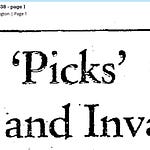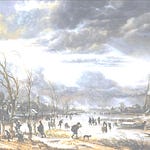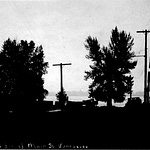This past weekend, Marjorie and I and friends went walking in a splendid, wooded area, Taylor Mountain. Like other forested spots near Seattle that have been protected by the city, county, state, or federal government, it is haven of beauty. Biggest were the holy trinity trees—Douglas firs, western red cedars, and western hemlocks—many so large I couldn’t wrap my arms around them. We debated if they were original growth and concluded they were not. Back in the day, no logger would have left behind any trees; these arboreal skyscrapers simply illustrated the stunning ability of our local climate and soil to crank out life.
We also reveled in old cedar stumps, complete with springboard notches, where loggers had stood to get above the tree’s base buttresses. Many of these mortal remains from the long dead trees were wider than any living tree we saw, and many had taken on a second life as a nursery for western hemlocks. The smallest were youthful seedlings, often joined by dozens of sibling sprouts. The biggest were trees that had interfingered their roots down, through, and around their stump, like a great embrace, as if the younger tree was thanking their elder for the gift of life.
On a much smaller scale were the hoards of slugs sliming across the trail. As abundant as I have seen in a while, the slithers came in three varieties: black, brown, and neither of those. The N.O.T. was the only one I felt confident in identifying. They were our legendary banana slugs, Ariolimax columbianus. (Two members of the U.S. Exploring Expedition collected the first known specimens of the species in May 1841. An assistant taxidermist John Dyes found one at Fort Nisqually and Augustus Case collected another at Port Discovery; sadly, both men are better known for the inlets that bear their names than for their contributions to malacology.)
Banana slugs have achieved their mythic status for many reasons. They are superb recyclers, aka detritivores and decomposers, with an astonishing ability to break down organic material and convert it to forms that other species can consume. Banana slugs produce a mucus, neither solid nor liquid, but a liquid crystal composed of semi-ordered molecules, which expand when wet, such as in a predator’s mouth; mucus is also an anesthetic, numbing a predator’s tongue or throat. Working in concert, these properties help slow down the process of banana slugs becoming someone’s lunch.
Mucus also enhances a banana slug’s sex life. When ready for the act, slugs release pheromones in their mucus that draws in a potential partner. Being a timid sort of guy, I won’t go into the details of copulation but suffice to say that it is unique, in part because they are hermaphrodites. Early on it involves biting and smacking. Then there’s the duration, which can be hours. And, finally, some banana slugs resort to apophallation, or biting off their partner’s penis post copulation. (I kid you not that this happens, that scientists study this behavior, and that they have a word for it.)
Stanford zoology professor Harold Heath was the first to describe apophallation, in a May 1916 article in The Nautilus. He initially noted that the five percent of adult banana slugs lacked a penis and that “the conviction became stronger that at some previous time the penis had been cast off.” So, he did what any good scientist would do, he sought field evidence and found it on “dark and gloomy” days. After several hours of the “act of conjugation…one of the animals turned its head and commenced to gnaw upon the walls of the organ.” “Hooray,” cried Heath!
He speculated that what remained from the successful gnawer could act as a plug to help keep in sperm. Or possibly, apophallation was Heath’s fault, in that his presence triggered the act of severance; perhaps gnawing was an adaptation to allow those involved to “separate more rapidly than usual” when alarmed. To this day, scientists have not determined why apophallation occurs. “The fate of the penis is likewise unknown,” concluded Heath.
Despite these many fine aspects of their life history, slugs get no respect and little love. In fact, they seem to merit the opposite for most people. Consider these poisoned words of Celia Thaxter, a 19th century poet. “It seems to me the worst of all the plagues is the slug…he is beyond repulsive, a mass of sooty, shapeless slime, and he devours everything.” As Mr. Shakespeare wrote, “The lady doth protest too much methinks.”
I have to admit that in my youth, I often did not treat slugs well. I won’t bore you with the details but I admit that I killed many, in many unpleasant ways, at the house where I grew up. I had been taught that slugs served no purpose and that they were devout devourers of lettuce and other vegetables. I am not proud of this past and I now realize that I wasn’t thinking; like many kids I wasn’t a great lover of lettuce so I should have been encouraging these inveterate eaters of vegetables instead of acting as I did. Yet another misspent part of my youth.
Now, as a wise adult, I have learned to savor the slug. Superbly adapted to their world, even if they have a bit of a kinky sex life, they are essential members of their community. They clean up debris. They recycle. They create food for others. As with so many aspects of the natural world, perhaps we should take heed, learn from them, and honor them for their contributions instead of condemning them for a lifestyle different than ours.
Indie bookstore day - I am excited to be a participant in this wonderful event at Edmonds Bookshop. I encourage you to shop local and support your independent bookstore; all are at the vanguard of the kind of intelligent, considered, considerate, respectful, diverse, and equitable thinking that we need more of in this country.
April 28, 2025 – Elliott Bay Books – 7:00 P.M. – I will be in conversation with poet Claudia Castro Luna about Wild in Seattle: Stories at the Crossroads of People and Nature.
April 29, 2025 – Third Place Books – 7:00 P.M. – I will be talking with author Laurie Frankel about Wild in Seattle: Stories at the Crossroads of People and Nature.
I have copies of Wild in Seattle for sale. Here’s a link. Cost is $28.00, which includes shipping, taxes, and my signature. The link takes you to a Square page. Shipments only in the U.S.

















Share this post